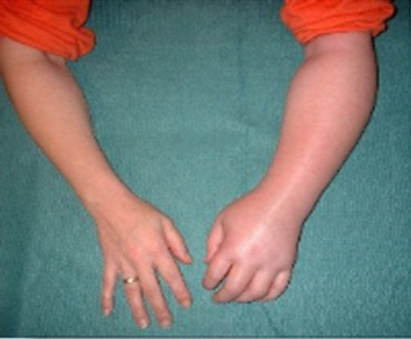Complex Regional Pain Syndrome(crps)
Pain Syndrome with autonomic dysfunction
 Definition:
Definition:
A painful syndrome, which includes regional pain, sensory changes such as allodynia, abnormalities of temperature, abnormal sudomotor activity, oedema and an abnormal skin color that occurs after an initiating event such as trauma"
CRPS I = Reflex
Sympathetic Dystrophy
CRPS II = Causalgia
The only difference between the two is the inciting event: minor trauma (I) versus major peripheral nerve injury (II).
Clinical manifestations of CRPS involve a triad of sensory, autonomic, and motor signs and symptoms. Intense pain and hyperesthesia are the hallmark of CRPS. The pain, characterized as aching, burning, pricking, or shooting, is localized deep in the somatic tissue. Abnormal sensations of hyperalgesia, predominantly to mechanical stimuli or upon joint movement, and allodynia are frequently present.
 Swelling, color, temperature changes, and sweating abnormalities consistent with autonomic changes.
Swelling, color, temperature changes, and sweating abnormalities consistent with autonomic changes.
Motor dysfunction in CRPS includes weakness, decreased ROM, tremor, dystonia, and myoclonus. Grip strength is often affected. Dystrophic changes include changes in nail and hair growth, fibrosis of the skin, hyperkeratosis, and thin glossy skin.
This is more common in the upper extremity, with a direct relationship to duration of symptoms.
Trophic Changes
The most common sign and symptom was swelling (in >90%) and color changes (in >70%), whereas sensory abnormalities were the least common clinical finding (~19%). In the vast majority of cases, CRPS remains confined to one limb.
Treatment options
Antiepileptic drugs
Sodium Channel Blockers
Intravenous lidocaine has strong sodium channel-blocking properties and has demonstrated efficacy in several uncontrolled studies of neuropathic pain and CRPS.
Bisphosphonates
N-METHYL-D-ASPARTATE ANTAGONISTS: KETAMINE
INTERVENTIONAL APPROACHES
Sympathetic Blockade
Stellate ganglion block
Lumbar sympathetic block
Spinal Cord Stimulation